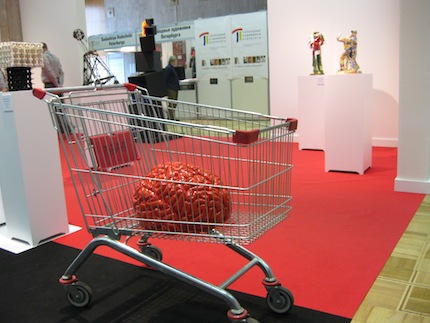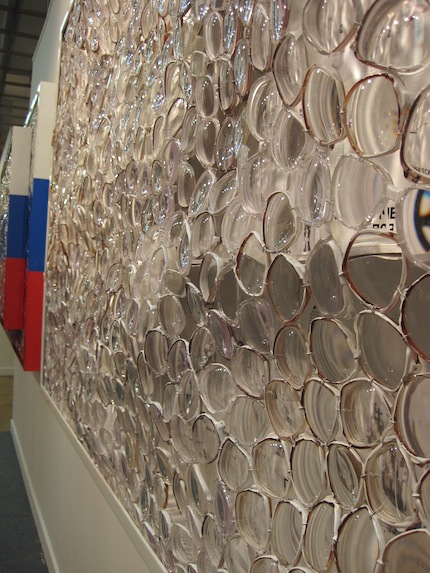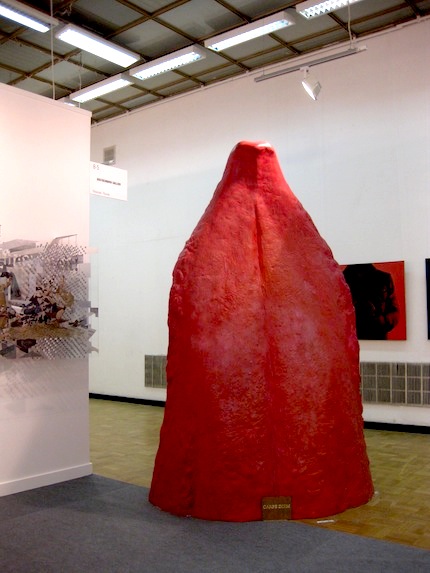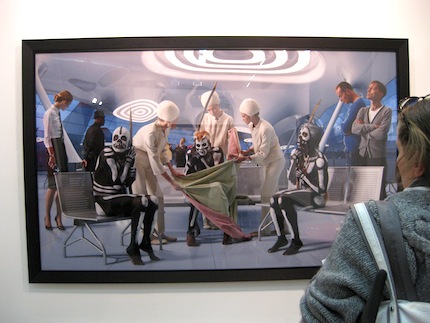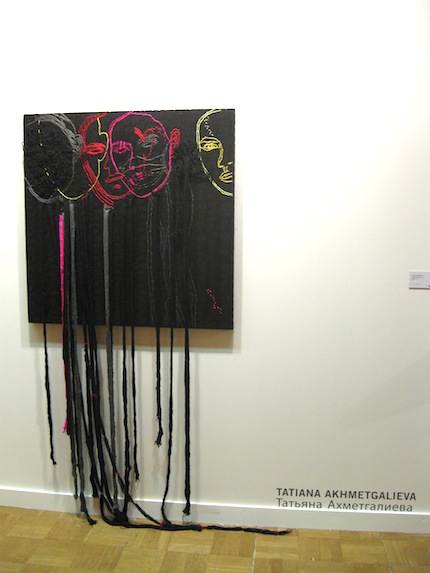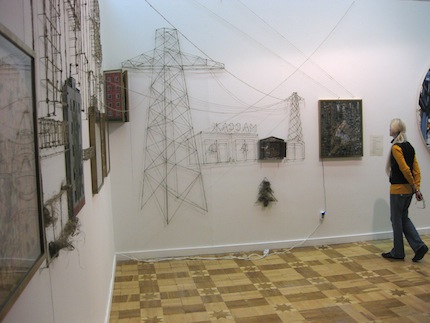
Art Moscow 2011: Regular Caviar
20/10/2011
Art Moscow debuted in 1996 and continues to hold on to the status of being the largest art fair in Eastern Europe; this autumn, from 21-25 September, it celebrated its 15th anniversary. The 4th Moscow Biennial of Contemporary Art was also going on currently; this created an overlapping of the Fair's and the Biennial's openings (this has been the case since 2009, when Art Moscow “moved” from spring to autumn), and for a moment, Moscow became the citadel of contemporary art.
Dmitry Tselkin
The air at Art Moscow 2011 was literally vibrating from the competitive battle among galleries for the attention of potential buyers. A symbolic indication of what sort of world you were about to enter was fittingly achieved by the displayed works selected from the collection of the New Rules fund, headed by the Moscow publisher and collector, Pierre Brochet (of French decent), and Dmitry Tselkin's “Brains for a Shopping Center” (2010): a shopping trolley containing an enlarged replica of a human brain.
The Numbers
Since we're talking about a market, the amount of items purchased should be mentioned. The turnover for Art Moscow 2011 was 3.38 million euros. (For comparison – last year's was 4.465 million euros, but in 2006, when the fair celebrated its 10th anniversary, profits were around 3.245 million euros.) 37 galleries from 14 countries participated in this year's Fair. Of the 37 galleries, 17 were from Russia, and 20 from elsewhere (Latvia, Estonia, Ukraine, Romania, Serbia, Austria, Hungary, Switzerland, USA, Cuba, Japan, Germany and Spain).
An interesting point is the proportion of sales – 69% of the Fair's income came from international galleries, while Russian galleries contributed just 31% of the total. It's interesting because this was a first for Art Moscow – never before had foreign galleries surpassed the income of local galleries. Russian galleries always, even if just slightly, have been ahead in the game. (For comparison, last year's income proportions were 44% for foreign galleries vs. 56% for local galleries; in 2006, it was 34% for foreign galleries vs. 66% for Russian galleries.)
The top three earning Russian galleries at this year's Fair were Frolov, Fine Art Gallery and The Marina Gisich Gallery. Of the foreign galleries, the winners were Art & Space (Munich, Germany), Barbarian Art Gallery (Zurich, Switzerland) and Tatyana Mironova's Gallery (Kiev, Ukraine).

David Datuna
In an interview after the Fair, the creative director of Art Moscow 2011, Christina Steinbrecher, stated that she was pleasantly surprised about the positive outcome: “No one was sure of what to expect in today's economic climate, but practically every stand sold something.” Even though collectors most likely had hoped otherwise, even small-format paintings by young artists weren't priced at any less than 5000 euros. One of the most expensive works of art sold was “Putin – Mona Lisa”, by the American artist, David Datuna (1974). It was represented at Art Moscow 2011 by Tatyana Mironova's Gallery from Kiev; its starting price was 100,000 euros, but it was eventually sold for 220,000 euros, to a Russian businessman who wished to stay anonymous. The Russian Prime Minister's portrait is made up of millions of tiny images of the Mona Lisa, and its bubble-like covering is made from eyeglass lenses.
However, another indicator that is just as important as sales results is – how “good” was the art on offer at the Fair? >>
The Tongue and Other Organs
After having taken a good look at Art Moscow 2011's offerings, the impressions of the Fair as a whole could be best represented by a single testament: a sculpture of a two meter-high tongue. It was direct, brutal and over-the-top (just enough to make all indications leading to the author himself completely forgotten, leaving only the strong impression of an image). But a tongue also senses taste, and the taste here was actually quite good. Anatomy has always been a generous source for works of art whose goal is to immediately catch the eye. Among other forms of expression, viewers were faced with the aforementioned brains, the gigantic tongue, and a scattering of individual works depicting genitalia, numbering close to ten; and of course, there were embryos. (Whereas at the concurrent Biennial, there was only a whisper of speculation as to the possibly obscured depiction of a penis.) Alongside the slew of examples of contemporary art with more diverse stories, as a whole, the works on display constituted a full-blooded assemblage that managed to avoid being a simply overt way to catch the attention of prospective buyers. It was like a rich hors d'oeuvre with caviar – caviar always seems to balance on the edge of being either disgusting fish eggs popping between your teeth or a delicacy one could die for. Art Moscow 2011 was a similar paradox.
What was missing was an escalation in the architecture of the exhibition. This year, all of the galleries were assigned equal space. On the one hand, that's only fair. On the other hand, it was a tad boring. Wandering along the labyrinth of stands, a powerful rift that would cut away the monotony, like a two- or even three-times larger stand, was lacking. Space, of course, is a rather insignificant aspect that could easily be overlooked as being labeled a fault, if only some of the strongest gallery expositions with their exuberant energy hadn't appeared as if they were hindered and boxed-in by the narrow walls, even attempting to break out of them.
AES+F
An example of the constrictions mentioned above was the Triumf gallery from Moscow, which had displayed large-format photographs from AES +F's latest video work, Allegoria Sacra, Angels and Demons, in their stand. (The video itself was screened at the Moscow Multimedia Museum, not at the Fair). And the Helsinki gallery, Forsblom, had so many valuable works of art that they overwhelmed each other, leaving the viewer in a bewildered state.
Scandinavia and the Baltics
The above mentioned Forsblom gallery was the only representative from Scandinavia that participated in the Fair. Their stand featured works by such artists as Julian Schnabel, Tatiana Akhmetgalieva, Ross Bleckner, Chen Jiagang, Peter Halley, Donald Sultan, Bernar Venet and Veikko Hirvimaki.
Tatiana Akhmetgalieva
Whereas from the Baltic States, three galleries took part in the Fair: Temnikova&Kasela from Tallinn (Estonia); and Rīgas Galerija and Alma from Riga (Latvia); this was Alma's debut at the Fair. The Estonian gallery Temnikova&Kasela represented the artists Kaido Oli, Jaan Toomik, Merike Estna and Dmitry Vrubel (Russia). The gallery Alma featured the paintings of Ēriks Apaļais and Barbara Gaile, while the long-standing participant of Art Moscow, Rīgas Galerija, displayed works by Ieva Iltnere, Rituma Ivanova and Leonards Laganovskis.
Vitas Stasunas
Lithuania wasn't represented at Art Moscow, unless you count the Russian artist with Lithuanian ancestry, Vitas Stasunas. Stasunas had a solo show at the Fair, and even before the Fair he was highly lauded in the press for his works of „sculptural painting“, which are very requested in Russia; he was represented by the prestigious Moscow gallery, XL. Even though Stasunas's installation – a city with houses, electricity cables and streets which were moulded as relief paintings with the above-mentioned accoutrements – surprised with its originality, the location of the installation was unfortunate. The work was exhibited on dividing walls at the end of the hall, which made one feel as if you're almost already out of the Fair's territory and it's time to turn back, instead of taking your time to experience the work.
Bonus Points
The Fair's bonus points, as they could be called, were three must-see expositions. The first was Takashi Murakami's tiny paintings, which were brought to Moscow by Japan's Whitestone Gallery, as well as a number of other works by Japanese artists: Yayoi Kusama, Masaaki Miyasako, Kazuyuki Futagawa and Nobuko Watabiki.
Dress "Herself"
The second bonuss point was the exhibition running parallel to the Fair, Translate / Transcribe, whose overall concept – a critical dialog between artists and the world in the information age – wasn't clearly delivered and the works of art created an idiosyncratic, colorful kaleidescope. However, the exhibition provided an opportunity to get a good look at a precursor of the future – the prototype of a dress/air purifier – „Herself“. The dress saw the light of day at the beginning of this year and was created through the cooperation of three UK institutes of higher learning: London College of Fashion and the Universities of Ulster and Sheffield. As a science layman, the elegant evening dress looked to be covered with cement-like blobs on fine material. However, the overall look was intriguing and the proposed function made it even more so.
And lastly, the third bonus point goes to the Moscow affiliate of Christie's Auction House for organizing a discussion with the following theme – the relationship between private collectors and public art collectors: the collectors' sense of responsibility, the supporting of museums, charity auctions and gifts. The forebearer of the discussion is the impressive contemporary art collection of the world-famous American IT programming magnate and philanthropist, Peter Norton (1943). 60 pieces of his collection will be auctioned off for charity at Moscow's Christie's in November of this year. >>
+++pagesplit+++
MARCK @ Art Moscow 2011
In evaluating the variety of mediums on offer at the Fair, it must be concluded that painting is still at the forefront. Even though there was no shortage of sculptures, video installations and photography, there were numerously more paintings, both large-format and miniatures. If looking at the historical chronology of mediums, then the most youthful stand belonged to the Zurich gallery, Barbarian Art Gallery. The multi-medium works by MARCK featured women swimming from one painting to the next, trying to either break free from the works or simply writhing in a cage. In terms of sales, the Barbarian Art Gallery was in the top rung of this year's Fair.
Summarizing the „aftertaste“ of the Fair – since it did begin with a Tongue – the state of the art fair, at least as seen through the prism of Art Moscow 2011, seems to have stabilized. While some galleries declined to participate, others came and went home with full bellies. Art lovers also didn't go home hungry.
